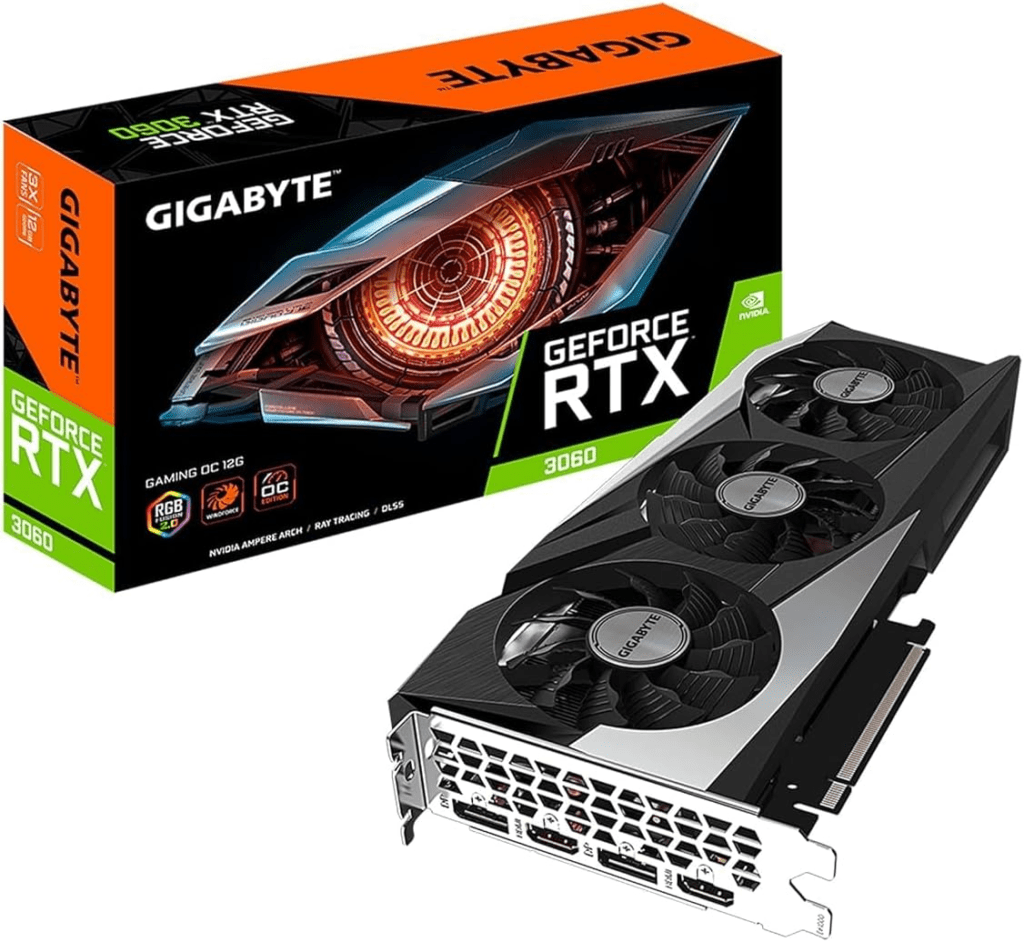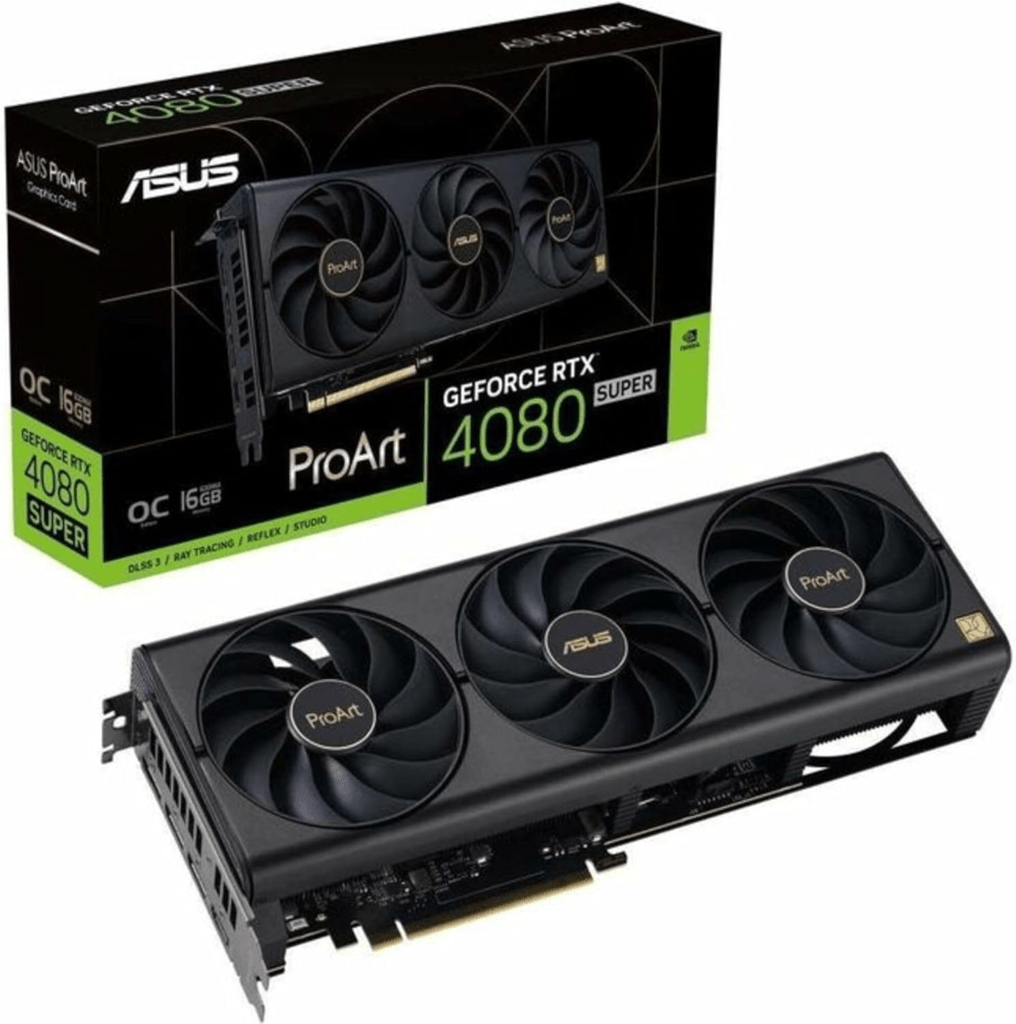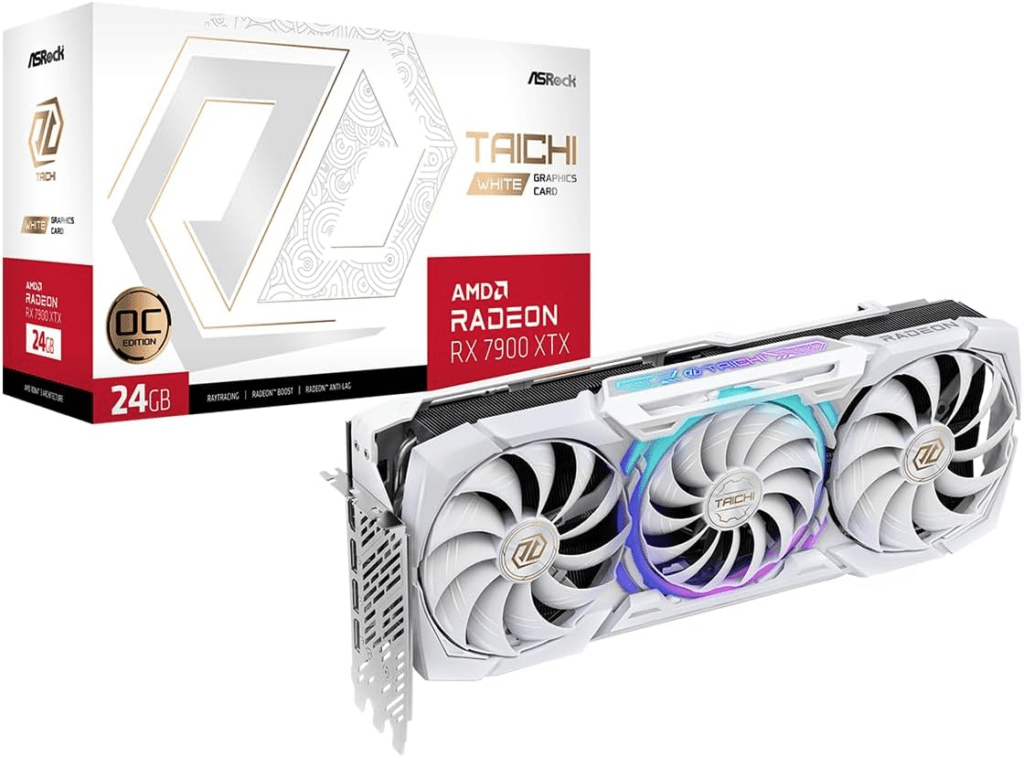Best Graphics Cards for Video Editing: Top 4 Picks in 2025
Producing high-quality video content requires the best graphics cards for video editing to improve workflow, reduce rendering times, and enhance playback. Whether you’re a professional working on 8K projects or a hobbyist creating social media content, a powerful GPU makes your work faster and more efficient. With so many options available, your choice will depend on your project needs, software, and budget. This guide highlights the top 4 graphics cards for 2024 and explains how they can elevate your video editing process.
1. Gigabyte GeForce RTX 3060 Gaming OC 12G

Features and Benefits:
The Gigabyte GeForce RTX 3060 Gaming OC 12G is one of the best graphics cards for video editing in the mid-range category. Powered by NVIDIA’s Ampere architecture, it offers excellent performance for editors who need a reliable GPU for 4K video editing, and even light 8K projects.
- Ampere Architecture: NVIDIA’s Ampere architecture provides more CUDA cores, faster memory bandwidth, and enhanced AI-based acceleration features. This makes the Gigabyte GeForce RTX 3060 one of the best graphics cards for video editing, especially when using software like Adobe Premiere Pro, After Effects, or DaVinci Resolve.
- 12GB GDDR6 Memory: With 12GB of VRAM, this card is well-suited for handling large video files and complex timelines. The extra memory ensures you can work on 4K or 8K footage without facing bottlenecks, making it a top choice for those looking for the best graphics cards for video editing in 2024.
- Windforce 3X Cooling System: Video editing can significantly stress your GPU, especially when rendering complex scenes. The Windforce 3X cooling system ensures your GPU stays cool and performs consistently, even during long editing sessions.
The Gigabyte GeForce RTX 3060 Gaming OC 12G is one of the best graphics cards for video editing for content creators looking for a balance between price and performance. It handles demanding tasks with ease, making it a popular choice among video editors.
Buy on Amazon2. ASUS ProArt GeForce RTX 4070 Ti

Features and Benefits:
The ASUS ProArt GeForce RTX 4070 Ti is another strong contender for one of the best graphics cards for video editing, particularly for professional video editors working with 4K, 8K, or VR content. Designed with creative professionals in mind, this GPU excels in both performance and reliability.
- NVIDIA Studio Drivers: The ProArt GeForce RTX 4070 Ti comes with NVIDIA’s Studio Drivers, which are optimized for creative applications. These drivers are built specifically to provide better performance and stability with popular video editing software such as Adobe Premiere Pro, After Effects, and DaVinci Resolve. The NVIDIA Studio Drivers make this one of the best graphics cards for video editing in 2024, especially for professional work.
- 8K Ready: If you’re editing high-resolution 8K footage, the ASUS ProArt GeForce RTX 4070 Ti can handle it with ease. With the power to manage large timelines, complex effects, and multiple layers of high-resolution footage, this card ensures smooth playback and faster rendering times.
- Triple DisplayPort 1.4: With the ability to connect multiple high-resolution monitors, you can set up an efficient editing workspace, which is crucial for professionals who rely on a multi-monitor setup.
The ASUS ProArt GeForce RTX 4070 Ti is undoubtedly one of the best graphics cards for video editing in 2024 for professionals who need top-tier performance and stability.
Buy on Amazon3. Asrock Radeon RX 6800 XT Phantom Gaming

Features and Benefits:
The Asrock Radeon RX 6800 XT Phantom Gaming stands out as one of the best graphics cards for video editing for those who prefer AMD’s RDNA 2 architecture. With 16GB of GDDR6 memory and AMD’s powerful GPU architecture, this card provides excellent performance for editing high-resolution video footage.
- RDNA 2 Architecture: The Radeon RX 6800 XT is built on AMD’s RDNA 2 architecture, which provides increased performance and power efficiency compared to its predecessors. This architecture is optimized for demanding tasks like video editing, making it one of the best graphics cards for video editing for professionals using AMD-powered systems.
- 16GB GDDR6 Memory: The 16GB of VRAM ensures that you can work on large 4K and 8K projects without worrying about running out of memory. This makes the Radeon RX 6800 XT one of the best graphics cards for video editing in terms of memory capacity.
- Ray Tracing Support: While ray tracing is typically associated with gaming, it also has applications in video editing, especially in rendering and visual effects. The Radeon RX 6800 XT’s support for hardware-accelerated ray tracing improves performance when working with advanced effects and color grading in software like DaVinci Resolve.
The Asrock Radeon RX 6800 XT Phantom Gaming is a great option for those who prefer AMD hardware and need one of the best graphics cards for video editing for handling large, complex projects.
Buy on Amazon4. MSI Radeon RX 570 ARMOR MK2 8G

Features and Benefits:
If you’re on a budget but still need one of the best graphics cards for video editing, the MSI Radeon RX 570 ARMOR MK2 8G is an affordable option that delivers solid performance for smaller projects. While it may not be the most powerful GPU on the market, it provides more than enough power for 1080p video editing and light 4K work.
- 8GB GDDR5 Memory: With 8GB of VRAM, the MSI Radeon RX 570 ARMOR MK2 is capable of handling 1080p video editing efficiently. For beginners or hobbyists working on smaller projects, this card can handle your workflow without issues.
- Polaris Architecture: Built on AMD’s Polaris architecture, this card offers decent performance and power efficiency. While it may not match the power of higher-end models like the Radeon RX 6800 XT, the Polaris architecture provides reliable performance for everyday editing tasks, making this one of the best graphics cards for video editing on a budget.
- Dual Fan Cooling System: The dual fan cooling system ensures that the card remains cool during long editing sessions, which helps maintain performance stability over time.
If you’re looking for a budget-friendly option that still offers great value, the MSI Radeon RX 570 ARMOR MK2 8G is one of the best graphics cards for video editing at an affordable price point.
Buy on AmazonFAQs
What factors should I consider when choosing the best graphics cards for video editing?
When selecting the best graphics cards for video editing, there are several key factors to consider to ensure optimal performance. The first and most important factor is the amount of VRAM (Video Random Access Memory). VRAM is critical for handling large, high-resolution video files and complex timelines with multiple layers, effects, and transitions. For 4K video editing, 8GB of VRAM is generally sufficient, but for more advanced projects, such as 8K editing or multi-layered 4K timelines, you may want to consider a card with 12GB or even 16GB of VRAM. The more memory you have, the more efficiently your graphics card can handle large files and effects without slowing down or encountering issues during rendering and playback.
Another significant factor is the GPU architecture. Both NVIDIA and AMD offer different architectures that have their strengths in video editing. NVIDIA’s GPUs use CUDA cores, which are highly effective in accelerating tasks in software like Adobe Premiere Pro, After Effects, and Media Encoder. These CUDA cores allow for faster rendering, real-time playback, and smoother performance when working with effects-heavy timelines. This makes NVIDIA cards some of the best graphics cards for video editing when working with Adobe’s suite of applications.
AMD, on the other hand, features RDNA 2 architecture, which is optimized for OpenCL-based applications like DaVinci Resolve. AMD’s GPUs also tend to offer better price-to-performance ratios, making them more affordable options for editors who need powerful hardware without breaking the bank. The RDNA 2 architecture allows for efficient power usage while delivering high-end performance in color grading, real-time effects, and rendering tasks.
Cooling systems are another critical consideration when choosing the best graphics cards for video editing. Video editing, especially when working with large resolutions or heavy effects, can be a resource-intensive task. A GPU that heats up quickly without proper cooling mechanisms can throttle performance or even crash during extended editing sessions. Therefore, it is important to look for a graphics card with an effective cooling system, such as dual or triple fan designs, to maintain optimal temperature and performance throughout your editing process.
Finally, consider the power requirements and the overall compatibility of the GPU with your system. High-end GPUs may require a more powerful power supply unit (PSU) and enough physical space in your computer case. Make sure to check the wattage and dimensions of the graphics card to ensure it fits within your system’s capacity.
In summary, the best graphics cards for video editing will have enough VRAM for the resolution you work with, a powerful architecture that aligns with the software you use, a robust cooling system for long editing sessions, and compatibility with your system’s power and space requirements.
Do I need an expensive GPU for video editing, or can I get by with a mid-range option?
Whether you need an expensive GPU for video editing or can get by with a mid-range option depends largely on the types of projects you work on and your specific editing needs. If you are working with 1080p footage, smaller 4K projects, or simpler timelines without too many effects, a mid-range GPU like the Gigabyte GeForce RTX 3060 Gaming OC 12G or the MSI Radeon RX 570 ARMOR MK2 8G can be more than adequate. These cards are some of the best graphics cards for video editing for hobbyists, beginners, or those working on less demanding projects. They offer sufficient performance for basic video editing tasks, including rendering, color correction, and light effects work.
For those dealing with more complex projects, such as high-resolution 4K or 8K footage, professional editing tasks, or working with multiple layers and advanced effects, a higher-end GPU is often a better investment. Cards like the ASUS ProArt GeForce RTX 4070 Ti or the Asrock Radeon RX 6800 XT Phantom Gaming are designed to handle more demanding workflows with ease. These GPUs come with higher VRAM capacities (12GB, 16GB, or more) and advanced architectures optimized for heavy-duty tasks, which make them some of the best graphics cards for video editing in professional settings.
While a mid-range card can handle light 4K editing, you may encounter limitations when working with multiple layers, effects-heavy timelines, or raw footage that requires real-time playback and advanced rendering. In such cases, you may experience lag, stuttering, or slower render times with a mid-range GPU.
Ultimately, if you work on professional-grade projects or need to future-proof your setup for higher-resolution formats (such as 8K), investing in a high-end GPU is worth considering. If you are more of a hobbyist or primarily work on less complex video editing tasks, a mid-range GPU will likely serve you well. In any case, choosing one of the best graphics cards for video editing within your budget ensures smoother performance and better productivity.
How much VRAM is enough for 4K and 8K video editing?
The amount of VRAM needed for video editing largely depends on the resolution of the footage you are working with and the complexity of your timelines. For 4K video editing, 8GB of VRAM is typically the minimum requirement. This amount of memory allows the GPU to process and store high-resolution frames efficiently, ensuring smooth playback and faster rendering. However, if you frequently work with multi-layered timelines, heavy effects, or raw footage, 12GB of VRAM or more will provide a noticeable performance improvement, especially in real-time playback and exporting times. The best graphics cards for video editing in 4K projects typically feature at least 8GB to 12GB of VRAM.
When editing 8K footage, more VRAM is necessary to handle the larger file sizes and greater processing demands. For 8K editing, it is recommended to have at least 12GB to 16GB of VRAM. The higher the VRAM, the better the card can handle multiple layers of 8K footage, effects, transitions, and color grading in real time without significant lag or slowdowns. Cards like the ASUS ProArt GeForce RTX 4070 Ti and the Asrock Radeon RX 6800 XT Phantom Gaming, which feature higher VRAM capacities, are some of the best graphics cards for video editing for professionals working with 8K footage.
In general, having more VRAM allows the GPU to store more data locally, which is essential for high-resolution video projects where the amount of data being processed is much larger. If you plan to work on future-proofing your editing setup for higher resolutions, investing in a GPU with more VRAM is a smart decision.
Is NVIDIA better than AMD for video editing?
The debate over whether NVIDIA or AMD produces the best graphics cards for video editing ultimately depends on your workflow and the software you use. Both brands offer excellent GPUs, but they excel in different areas depending on the type of video editing tasks you perform and the software you rely on.
NVIDIA GPUs are generally considered superior when working with Adobe products like Premiere Pro, After Effects, and Media Encoder. This is largely due to NVIDIA’s CUDA cores, which allow for hardware acceleration in many Adobe applications. CUDA cores provide significant performance boosts in tasks like rendering, applying effects, and working with high-resolution footage. As a result, NVIDIA GPUs, such as the Gigabyte GeForce RTX 3060 or ASUS ProArt GeForce RTX 4070 Ti, are often regarded as some of the best graphics cards for video editing when using Adobe software.
AMD GPUs, on the other hand, shine in OpenCL-based applications, particularly DaVinci Resolve. AMD’s RDNA 2 architecture provides great performance and value, making AMD cards more cost-effective for editors who prefer DaVinci Resolve or other OpenCL-optimized programs. The Asrock Radeon RX 6800 XT Phantom Gaming, for example, is an excellent choice for editors who need powerful performance without the premium price tag of high-end NVIDIA cards.
In terms of value for money, AMD tends to offer better price-to-performance ratios, especially for editors on a budget. However, if your workflow revolves around Adobe products, NVIDIA’s CUDA cores can offer significant advantages in rendering and real-time playback. Ultimately, both brands offer great options, so the best graphics cards for video editing depend on the software and specific workflows you follow.
Can a budget GPU handle video editing tasks?
Yes, a budget GPU can handle video editing tasks, but the performance will depend on the complexity of the projects you work on. Budget-friendly GPUs like the MSI Radeon RX 570 ARMOR MK2 8G are some of the best graphics cards for video editing on a budget. These cards are well-suited for handling 1080p video editing and basic 4K editing, making them excellent options for beginners or hobbyists.
For example, if your video editing involves relatively simple timelines, basic transitions, or light color grading, a budget GPU can offer decent performance. The MSI Radeon RX 570, with 8GB of GDDR5 memory, is capable of handling smaller 4K projects as long as they don’t involve too many complex effects or layers.
However, for more advanced projects involving high-resolution 4K or 8K footage, multiple layers, and heavy effects, budget GPUs may struggle with real-time playback and slower render times. For these types of tasks, mid-range or high-end GPUs are generally required to avoid performance bottlenecks.
If you’re just starting in video editing or primarily work on less demanding projects, a budget-friendly card like the MSI Radeon RX 570 ARMOR MK2 can still provide a smooth editing experience. As you progress or start working on more complex projects, you may eventually need to upgrade to one of the best graphics cards for video editing that can handle more demanding workflows.
In conclusion, while budget GPUs can certainly handle simpler video editing tasks if you plan to work on more complex, higher-resolution projects in the future, it may be worth investing in a more powerful GPU.
Conclusion
Choosing the right GPU is crucial for a smooth and efficient video editing workflow. The best graphics cards for video editing can make a significant difference in rendering times, playback smoothness, and the overall speed of your editing process. Whether you’re working on simple 1080p projects or complex 8K timelines, having the right GPU can enhance your productivity and allow you to focus on the creative aspects of your work.
The Gigabyte GeForce RTX 3060 Gaming OC 12G offers a great balance between price and performance, making it a top pick for those looking for a mid-range solution. The ASUS ProArt GeForce RTX 4070 Ti is ideal for professionals who need top-tier performance and reliability, especially when working with 8K video. For AMD fans, the Asrock Radeon RX 6800 XT Phantom Gaming is a powerful option that excels in OpenCL-based applications like DaVinci Resolve. Finally, the MSI Radeon RX 570 ARMOR MK2 8G is a budget-friendly choice that still offers solid performance for smaller projects.
Looking to upgrade other parts of your editing setup? Check out our guides on the best wireless routers for large homes and the best 4K monitors for graphic design.
For additional insights on the latest video editing hardware, visit PCMag or Tom’s Hardware for expert reviews and recommendations.
